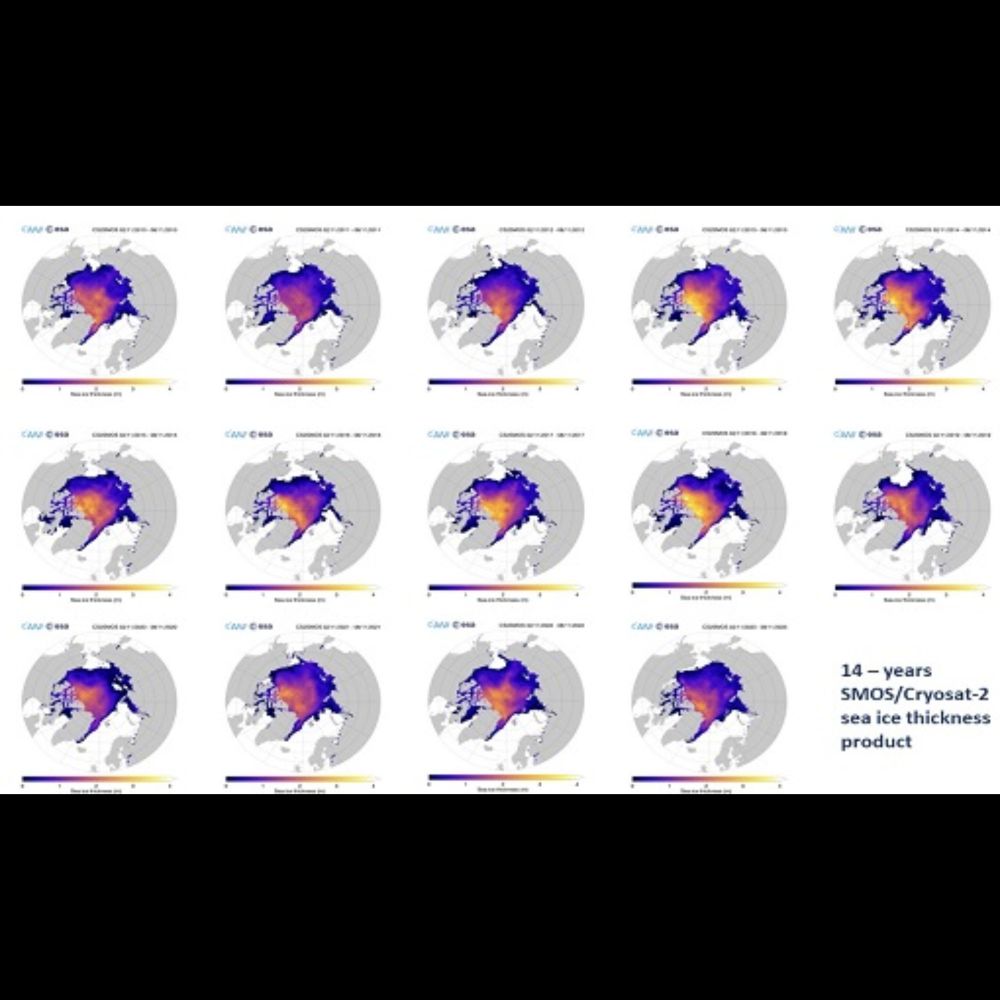
Sea ice thickness from CryoSat-2/Sentinel-3/SMOS in the northern hemisphere from October 15 to October 21, 2025 (near real-time processing)
Operational processing of the Level-4 (L4) CryoSat-2/Sentinel-3/SMOS (CS3SMOS) sea ice thickness product has been started for the Arctic 2025/26 winter season. The product version has seen a major upgrade from v206 to v300.
#Arctic #Climate @esaclimate.bsky.social
spaces.awi.de/spaces/CS2SM...
23.10.2025 16:16 — 👍 7 🔁 1 💬 0 📌 0
A new satellite approach tracks drifting Arctic sea ice, giving us clearer, more accurate maps of ice thickness. 🛰 A useful step for monitoring climate change in the polar regions. Read more: climate.esa.int/en/news-even...
16.09.2025 13:42 — 👍 16 🔁 9 💬 0 📌 0
It is truly the last look at the CryoSat-2/SMOS (CS2SMOS). In October we will continue with CryoSat-2/Sentinel-3/SMOS (CS3SMOS) in the #Arctic. CS3SMOS will also be generated for #Antarctic #seaice.
22.04.2025 12:24 — 👍 4 🔁 0 💬 1 📌 0
The @copernicusecmwf.bsky.social and @wmo-global.bsky.social European State of the Climate Report is launched today
🌐 more than 40 datasets
👩🔬 over 100 scientists
🗺️ > 130 charts and graphics
Check it out: climate.copernicus.eu/ESOTC
🌏🌡️🧪⚒️🌊🛰️
15.04.2025 05:19 — 👍 131 🔁 62 💬 2 📌 4
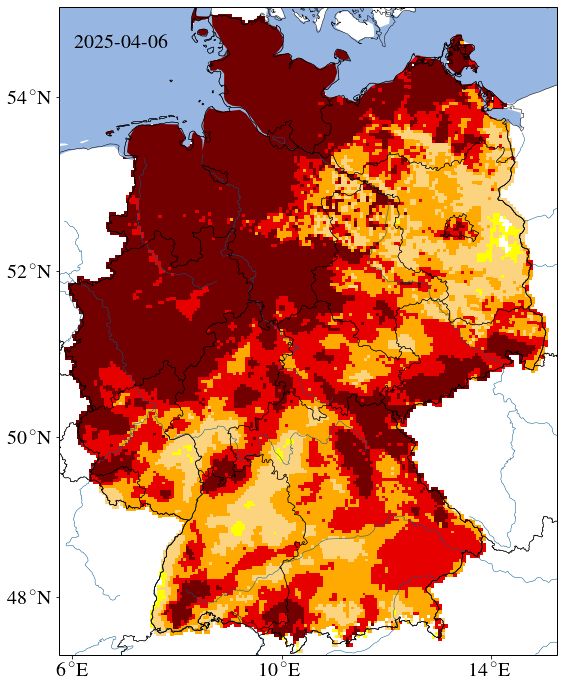
Map of German draught monitor showing "exceptional draught" in all over northern germany
Urgh, that looks unpleasant. I could well use some of this water here. Our garden is already in need of watering since March due to "exceptional draught"
map: UFZ Drought Monitor / Helmholtz Centre for Environmental Research.
08.04.2025 10:12 — 👍 1 🔁 0 💬 1 📌 0
Happy launch day anniversary 🥳
Btw, any chance that @esa_cryosat moves over here?
08.04.2025 10:02 — 👍 2 🔁 0 💬 0 📌 0
🎈🎈🎈🎈🎈🎈🎈🎈🎈🎈🎈🎈🎈🎈🎈
08.04.2025 09:56 — 👍 5 🔁 0 💬 0 📌 0
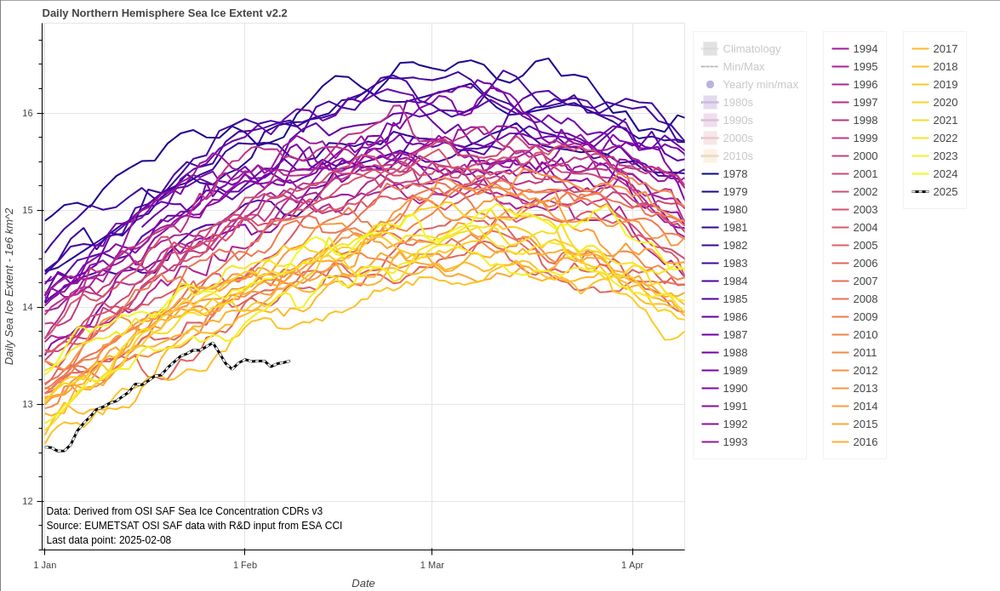
Line graph showing the daily sea-ice extent for the Arctic from 1978 to the present time in 2025. 2025 is shown in the thick black line to the left, while the previous years are presented in plasma colormap with the earliest years in purple and most recent years in yellow'ish. Since January 27th, the normal winter increase in sea-ice extent has completely stopped. Arctic ice extent is now record low and significantly lower than previous years.
Data source is the OSI SAF sea-ice index v2.2.
The full stop of the increasing winter sea-ice extent in the Arctic has now lasted for two weeks...
🌊⚒️🧪🥼❄️
10.02.2025 07:51 — 👍 118 🔁 71 💬 5 📌 11
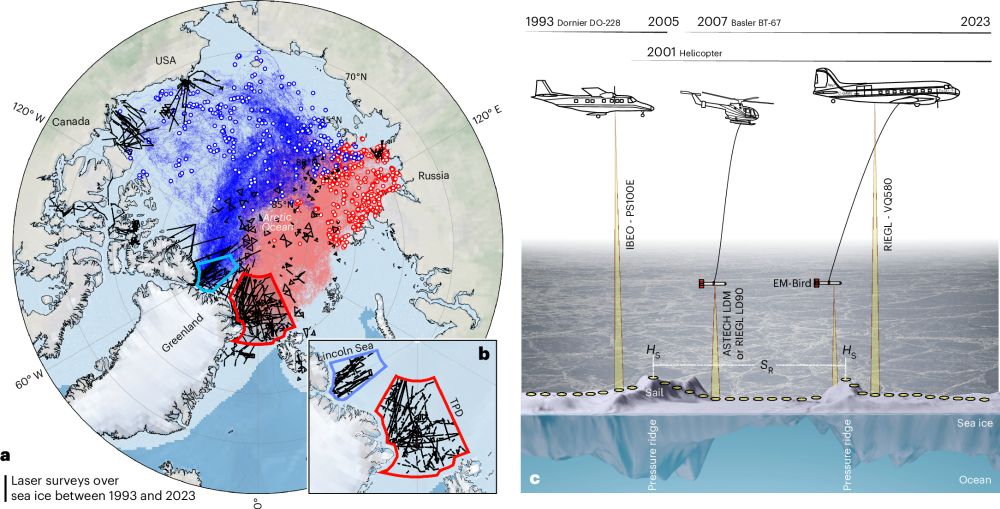
Smoother sea ice with fewer pressure ridges in a more dynamic Arctic
Nature Climate Change - Pressure ridges, a characteristic feature of Arctic sea ice, play an important role in the ecosystem but pose challenges to shipping. Here the authors use aircraft...
Sea ice paper alert, congratulations to my colleagues!
Krumpen, T., von Albedyll, L., Bünger, H.J. et al. Smoother sea ice with fewer pressure ridges in a more dynamic Arctic. Nat. Clim. Chang. (2025). doi.org/10.1038/s415...
#Arctic #climate 🌊 🥼❄️
rdcu.be/d5rtv
06.01.2025 18:51 — 👍 35 🔁 16 💬 0 📌 2
I could go on and on with this. There are so many logistical challenges that I don't think this project will ever be applied on the large scale in the central Arctic. I only see possibilities for to apply this locally, e.g. strengthen regions where sea ice is used for travelling.
13.12.2024 09:19 — 👍 2 🔁 0 💬 0 📌 0
The test on landfast sea ice is also wildy optimistic. Actual drift ice has a lot more topography, and the affected area will be smaller. They will also loose a lot of these pumps due to sea ice deformation.
13.12.2024 09:15 — 👍 1 🔁 0 💬 1 📌 0
This reseeding will also be needed mostly in the Russian exclusive economic zone. Anyone thinks it is likely that there will be a permission to visit this area with > 100000 autonomous vehicles every year?
13.12.2024 09:10 — 👍 1 🔁 0 💬 1 📌 0
The entire concept seems to be completely oblivous of the fact that sea ice does not stay in one place. A good portion of it ends up in the North Atlantic where it will melt no matter how thick it is. This means constant reseeding of 100`000s of square kilometers within months only.
13.12.2024 09:06 — 👍 1 🔁 0 💬 1 📌 0
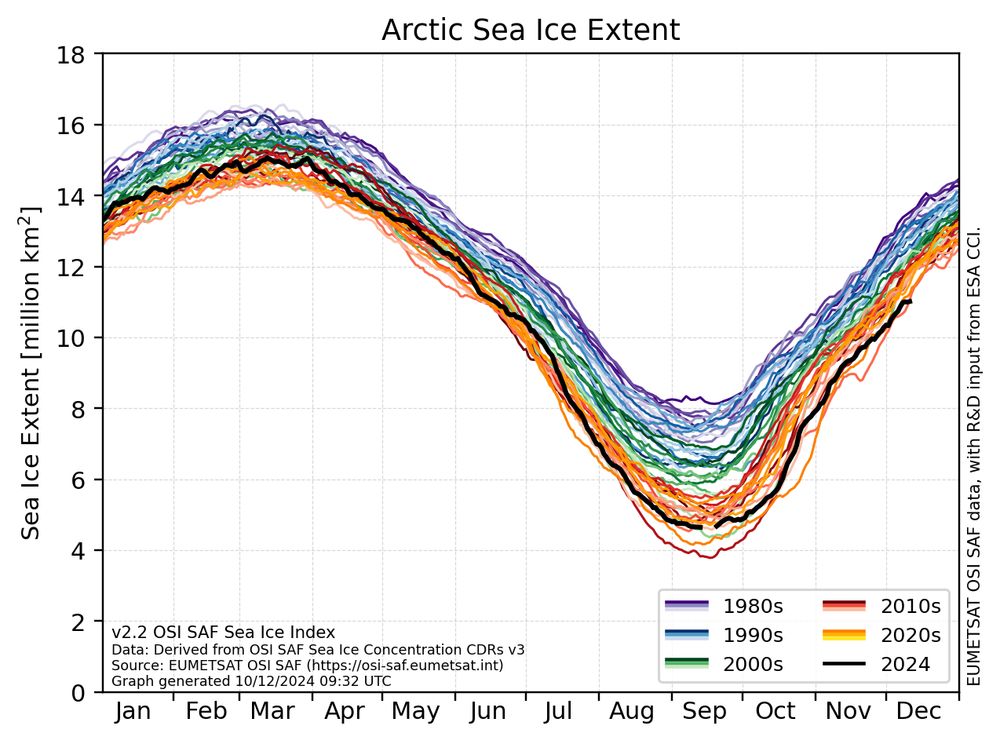
Line graph showing the daily sea-ice extent for the Arctic for the period 1978 to 2024. 2024 is shown in black while the previous years are shown in decadal-grouped colors. Most recent observations from December 2024 show record-low ice extent for this time of the year.
Data source is the OSI SAF sea-ice index v2.2.
Sea-ice extent in the Arctic just took a sharp turn and is now located in "record-low for this date" region 📉
🌊🧪⚒️
11.12.2024 11:07 — 👍 116 🔁 33 💬 6 📌 5
Newly created starter pack for Polar Oceanography 🌊❄️
My follow list is far from complete, so let me know if I have missed you/someone else you think should be included!
go.bsky.app/851nQgx
09.11.2024 16:02 — 👍 38 🔁 19 💬 6 📌 1

North pole view of Arctic sea ice thickness from March 8–15 2024, measured by SMOS & Cryosat-2. Thickness ranges from 0.04 (light green) to 4 meters thick (dark blue). The thickest ice is concentrated along the coast of Arctic Canada and Greenland.
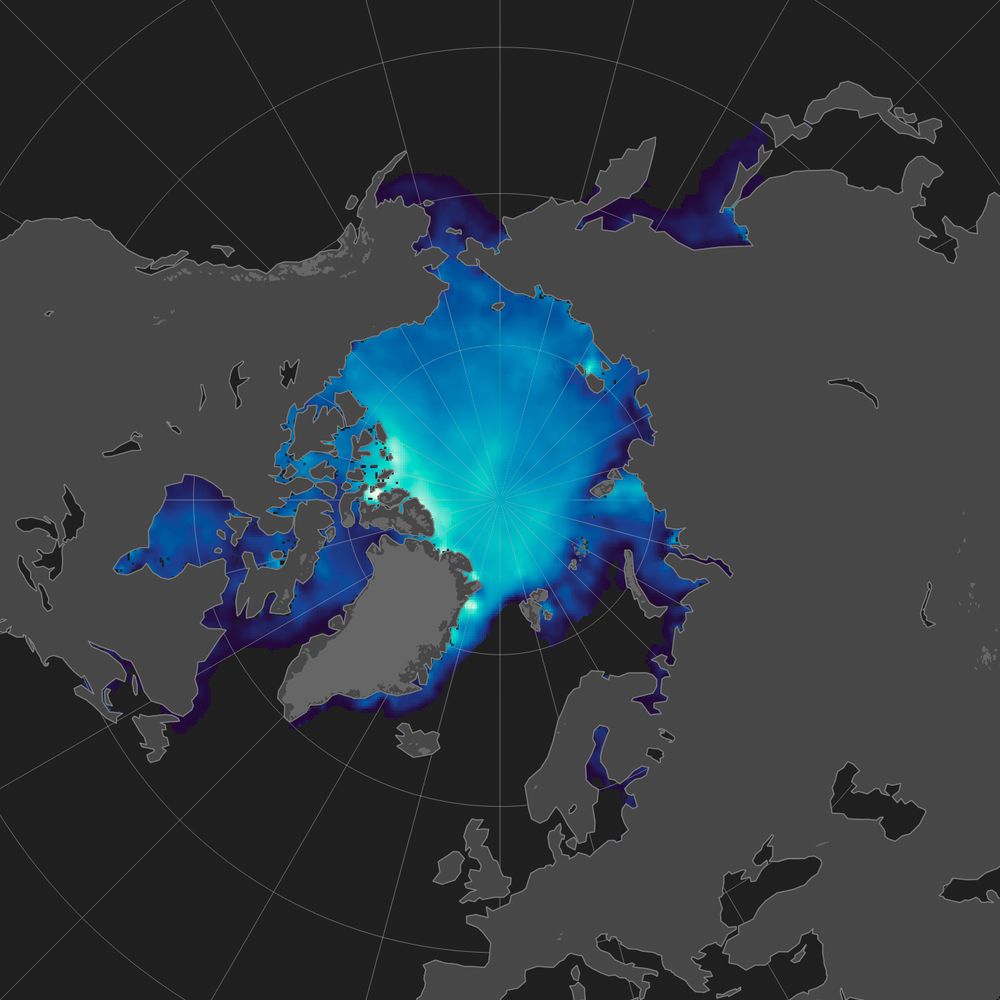
North pole view of Arctic sea ice thickness from March 8–15 2024, measured by SMOS & Cryosat-2. Thickness ranges from 0.04 (dark blue) to 4 meters thick (light green). The thickest ice is concentrated along the coast of Arctic Canada and Greenland.
Light or dark mode?
26.07.2024 00:09 — 👍 4 🔁 1 💬 4 📌 0
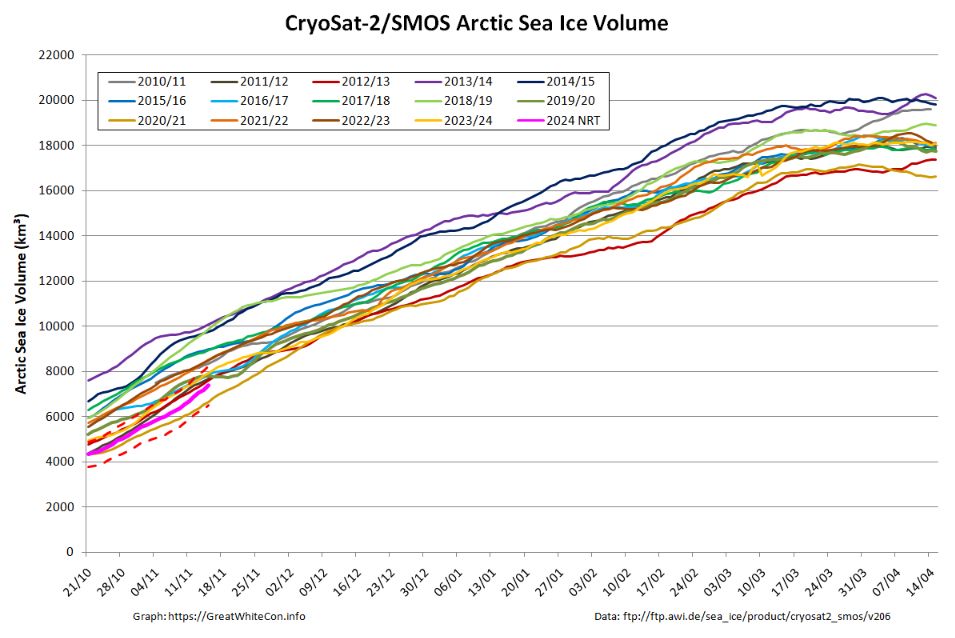
CryoSat-2/SMOS merged Arctic sea ice volume graph on November 15th 2024
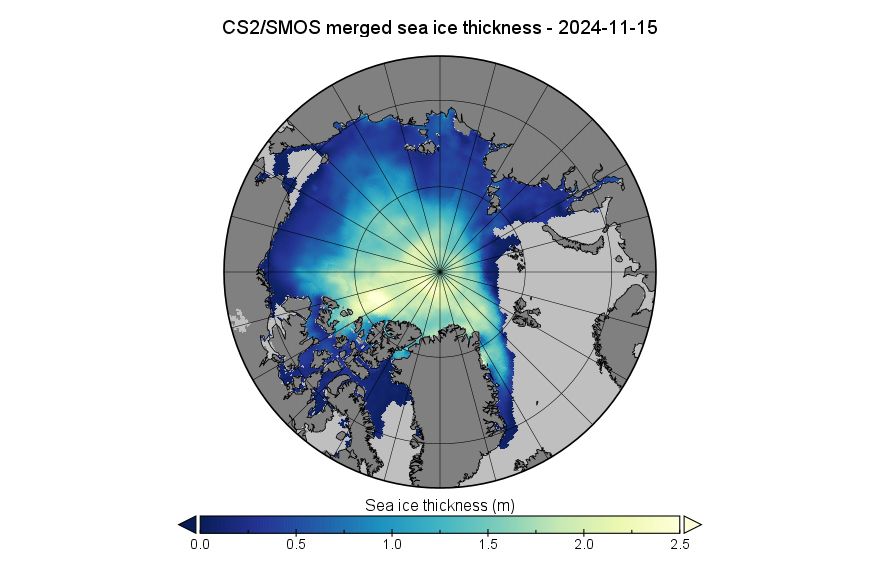
CryoSat-2/SMOS merged Arctic sea ice thickness map on November 15th 2024
Here's our mid month update on #CryoSat2/#SMOS merged #Arctic #SeaIce thickness and volume:
greatwhitecon.info/2024/11/fact...
18.11.2024 13:12 — 👍 8 🔁 3 💬 0 📌 0
They now exist.
Marine biogeochemistry
go.bsky.app/TK79r4w
Polar ocean
go.bsky.app/851nQgx
Physical oceanography
go.bsky.app/Eb6xX19
Sea level and coastal erosion
go.bsky.app/B6spBdu
09.11.2024 19:02 — 👍 114 🔁 67 💬 20 📌 11
Find your #remotesensing buddies here 💓
go.bsky.app/4PMRhNL
10.11.2024 22:10 — 👍 25 🔁 18 💬 2 📌 0
Some good news: The Advisory Committee for Earth Observation (ACEO) has recommended extending the SMOS mission until the end of 2028, alongside CryoSat-2 and SWARM. ❄️🧊🛰️
11.11.2024 08:19 — 👍 19 🔁 9 💬 0 📌 0
Just started a starter feed listing Arctic and Antarctic communicators already on Bluesky
...please let me know who else to add & apologies to all I've missed - just let me know and I'll sort it
go.bsky.app/7RL1i9C
08.11.2024 05:38 — 👍 45 🔁 24 💬 9 📌 4
Welcome
@berkeleylabemp.bsky.social
@miamirosenstiel.bsky.social
@miamiresilience.bsky.social
@climatereefs.bsky.social
@ficlima.bsky.social
to my starter pack of research organizations, centers and departments that bring folks together to tackle climate.
Click here to follow some or all:
07.11.2024 14:07 — 👍 296 🔁 97 💬 24 📌 9
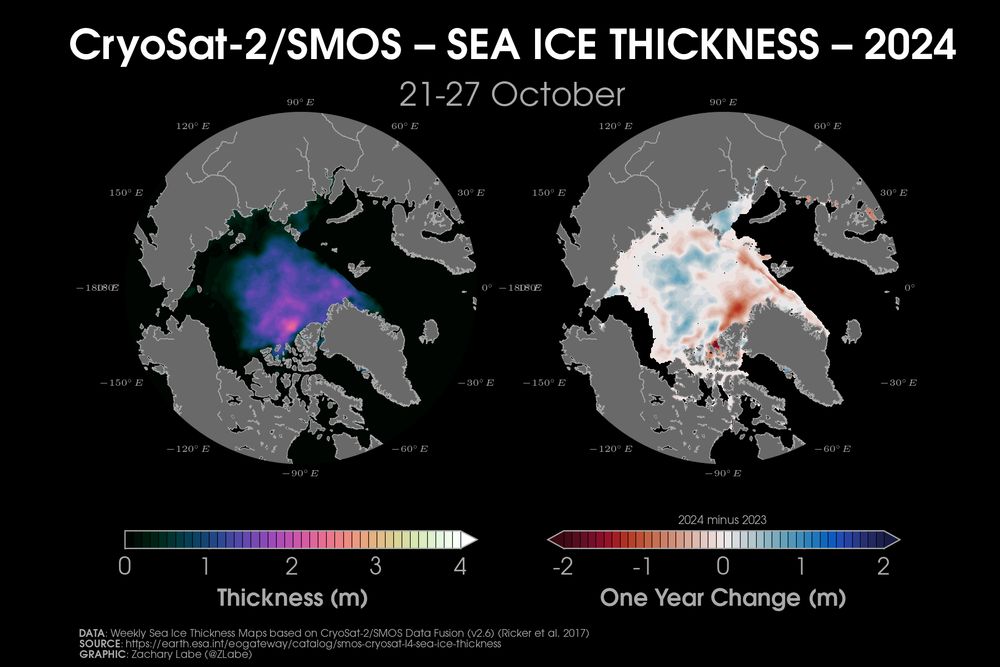
Two polar stereographic maps showing Arctic sea ice thickness from CryoSat-2/SMOS and the difference relative to the previous year (October 2023). Ice is thinner than last year toward Greenland.
A first look at the CryoSat-2/SMOS merged product for #Arctic sea ice thickness this fall. Now looking after the melt season, we see thinner ice north of Greenland relative to last year and thicker in the Central Arctic.
This graphic will now be updated weekly at zacklabe.com/arctic-sea-i... 🌊⚒️
29.10.2024 11:57 — 👍 34 🔁 16 💬 0 📌 0
I can see very localized benefit where sea ice is used for transportation etc. But "saving sea ice" requires deploying millions of these pumps every winter for decades mainly in the Russian exclusive economic zone. Nothing but a pipe dream.
25.09.2024 09:09 — 👍 3 🔁 1 💬 1 📌 0

Four polar stereographic maps showing Arctic sea ice thickness for the month of December in 1983-1992, 1993-2002, 2003-2012, and 2013-2022. Thickness is shown with colors from black at 0 meters to purple at 2.5 meters to white at 5.0 meters. Sea ice in thinning in all regions over time.
The disappearance of thicker Arctic sea ice by decade in December... 🧊📉
More info on data: climatedataguide.ucar.edu/climate-data...
11.12.2023 19:19 — 👍 20 🔁 10 💬 0 📌 0
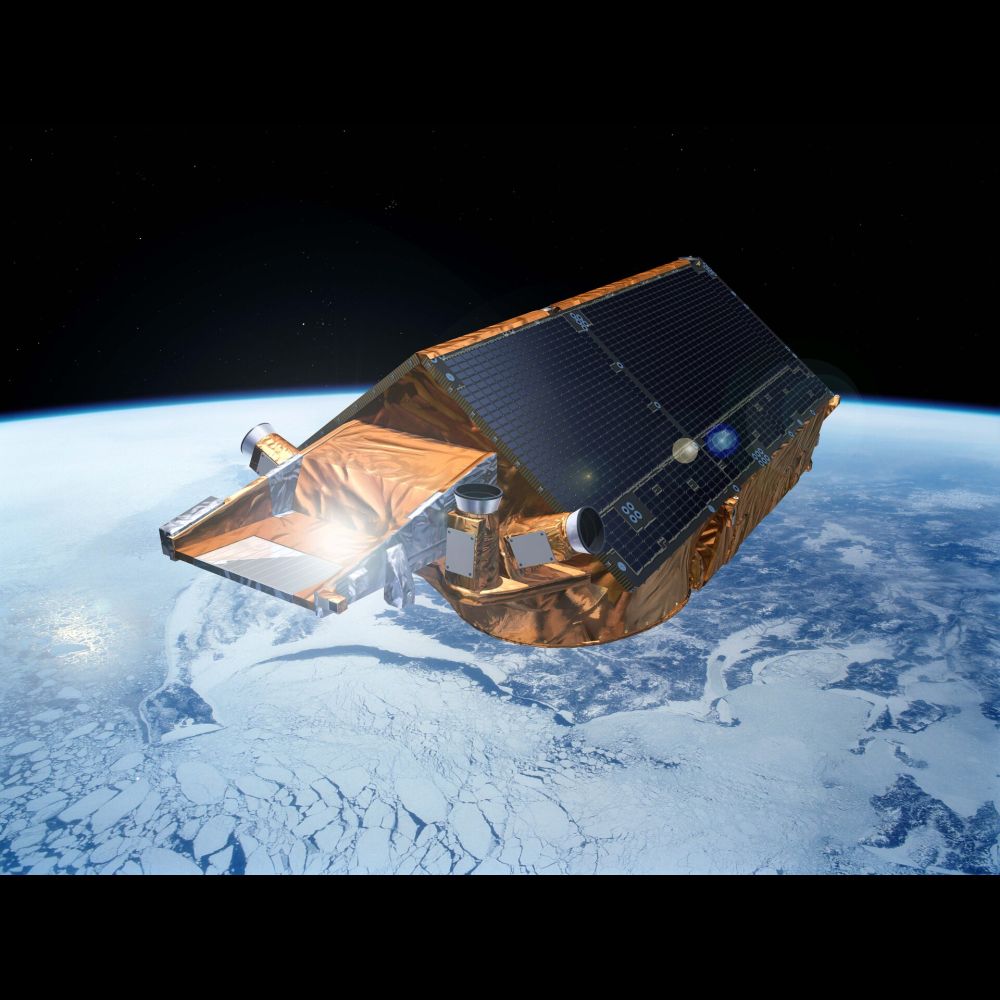
Life beyond the leak for ESA’s CryoSat
And with this good news for CryoSat-2 (and the SMOS mission extension) to many more years!
www.esa.int/Enabling_Sup...
05.12.2023 08:43 — 👍 0 🔁 0 💬 0 📌 0
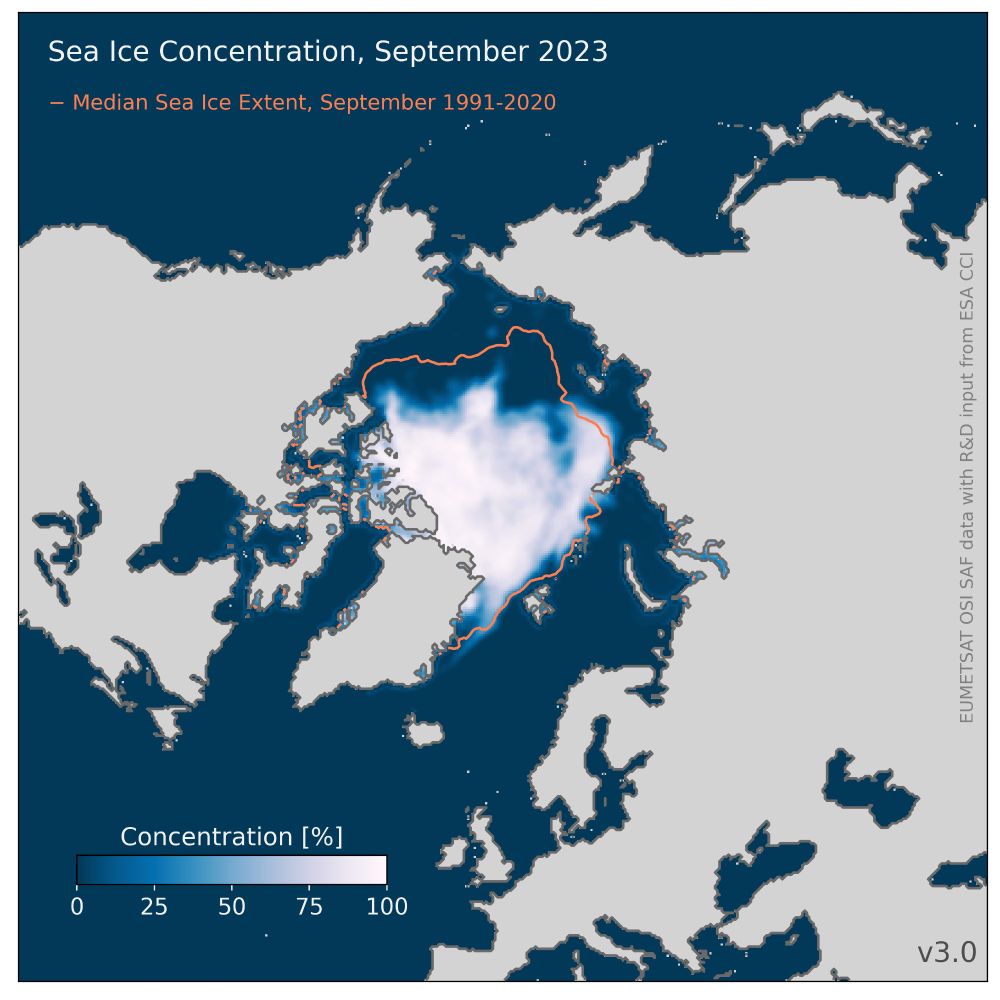
Map showing the Arctic sea-ice concentration averaged over November 2023. For comparison, the mean November sea-ice extent for the period 1981-2010 is represented by an orange contour.
Source data is OSI SAF sea-ice concentration CDR v3.0
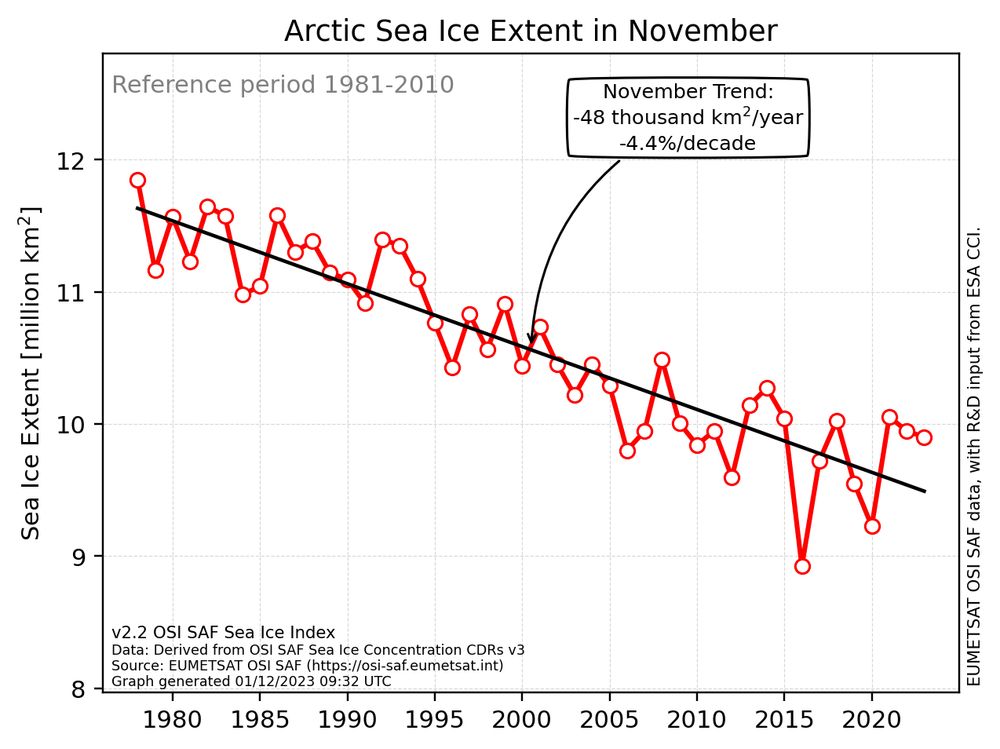
The line graph displays the sea-ice extent in the Arctic for the month of November from 1978 to 2023. In 2023, the extent was below average, ranking as the eighth lowest.
Data source is the OSI SAF sea-ice index v2.2.
Arctic sea ice in November 2023:
- The extent of Arctic ice for this month is the 8th lowest on record.
- The ice has shifted north in most areas, except in the Greenland Sea where there is an above-average amount of ice for November.
🧪⚒️
01.12.2023 10:37 — 👍 9 🔁 4 💬 1 📌 2

Map showing the Antarctic sea-ice concentration averaged over November 2023. For comparison, the mean November sea-ice extent for the period 1981-2010 is represented by an orange contour.
Source data is OSI SAF sea-ice concentration CDR v3.0
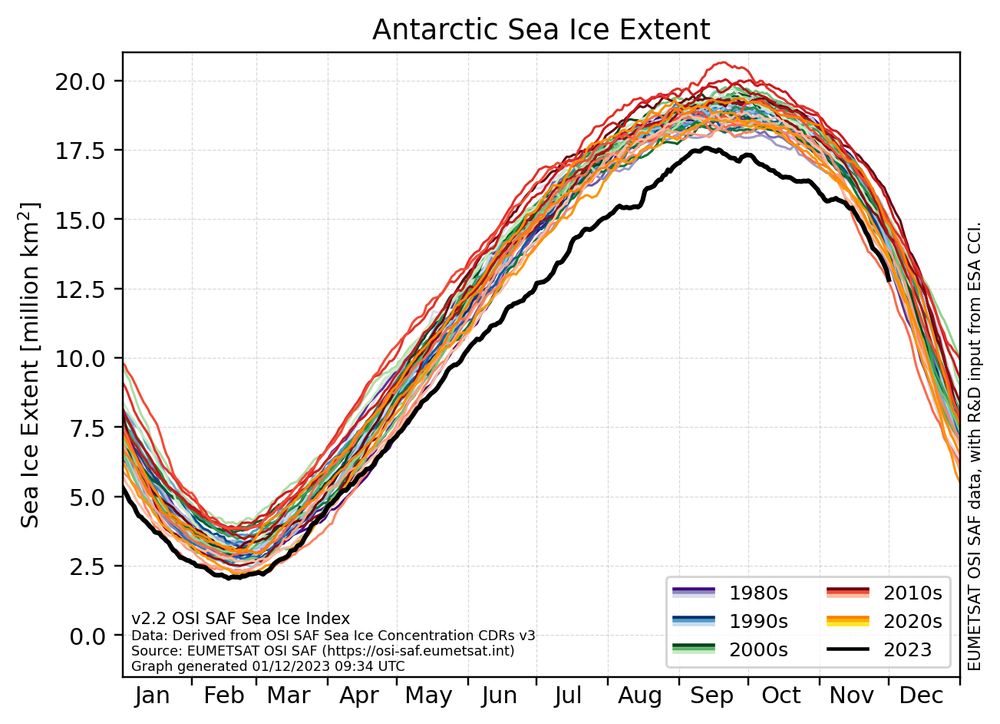
Line graph showing the daily sea-ice extent for the Antarctic for the period 1978 to 2023. 2023 is shown in black while the previous years are shown in decadal-grouped colors.
Data source is the OSI SAF sea-ice index v2.2.
What a winter season in the Antarctic!
For November 2023, the ice extent was "only" second-lowest on record.
Ice is missing especially in the Ross and Weddell Sea.
⚒️🧪
01.12.2023 10:52 — 👍 13 🔁 4 💬 0 📌 1
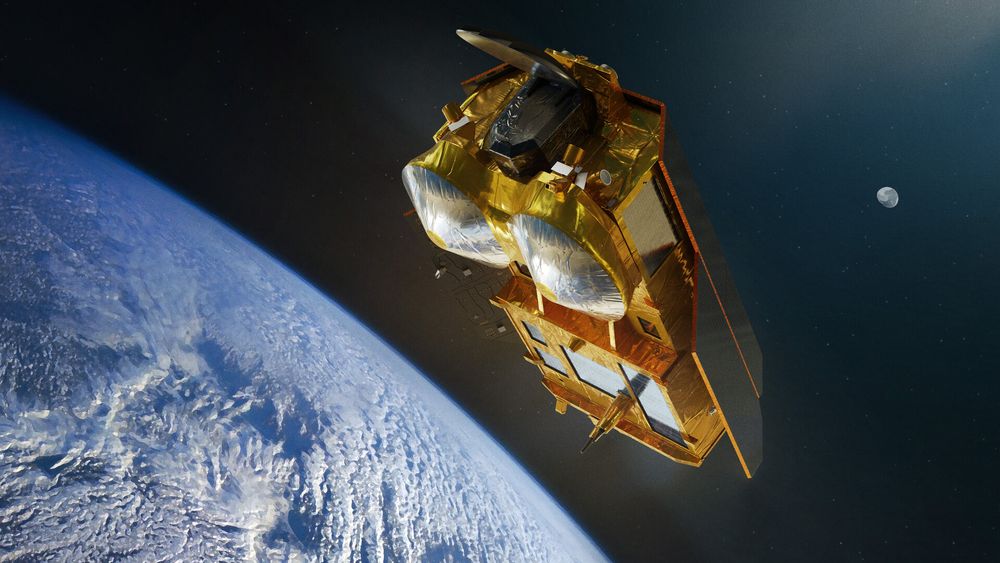
Artist's impression of the CRISTAL satellite orbiting Earth
At ESA ESTEC for the CRISTAL Mission Advisory Group meeting. The first flight model parts are already being made! We are still looking at a launch date in 2027!
(Image: ESA)
27.11.2023 09:28 — 👍 1 🔁 1 💬 0 📌 0
Developing Ocean-Atmosphere Coupled Data Assimilation at #ECMWF to make your weather forecasts better.
Expect some sharing of good dogs here too
[bridged from https://fediscience.org/@phil_browne on the fediverse by https://fed.brid.gy/ ]
Signal is an end-to-end encrypted messaging app. Privacy isn’t an optional mode, it’s just the way that Signal works. Every message, every call, every time.
President of Signal, Chief Advisor to AI Now Institute
Professor for Earth observation, Technical University of Munich.
Assistant Professor for Geoinformatics - Spatial Data Science at Trier University, Germany. Earth Observation. Remote Sensing. Geoinformatics. Data Science. Open Science.
🇬🇧 🇪🇺 physicist, philosopher, lead https://www.worldweatherattribution.org/, author of Climate InJustice https://greystonebooks.com/collections/current-affairs-politics/products/climate-injustice, she/her
• Researching sediments from the Deep Sea to Mars
• Ph.D. in tiny rocks, oceans, + squiggly lines
• Exploring extreme environments using robot friends
Prev 🐥: @ MarsRoverMapper (ODU + NASA-JPL)
https://geoshanz.blogspot.com
Founded in 2022, the 🇧🇪 Belgian Climate Centre focuses on climate science, fostering collaboration, supporting research, and providing decision-makers with scientific expertise | climatecentre.be | socials & more: https://linktr.ee/belgianclimatecentre
Engaged in Microbial Ecology and Genomics research from Alpine to Polar Ecosystems. Project Scientist at the National Centre for Polar and Ocean Research (NCPOR), India.
Glaciologist & Deputy Lead Scientist @nsidc.bsky.social. Climate Science Engagement Lead @ciresceee.bsky.social. 2025 AGU Climate Comms Awardee. More at www.changingice.com. Views my own!
Ukrainian perspective on the media worldwide 🌎
Website: https://theukrainianreview.info/
PREreview is a free and open platform for the crowdsourcing of #preprint reviews, a resource center, and a convener. Working to make science and scholarship more equitable, transparent, and collaborative.
To learn more, visit: https://linktr.ee/prereview
Politikwissenschaftlerin usw
Former soldier. Student of leadership & national security. Now a teacher, author, speaker & analyst. Always looking for civility…and new adventures.
https://www.linkedin.com/in/mark-hertling-dba-57987066
Media platform covering global conflict zones. Focus on the Ukraine-Russia war. Consider supporting us once via buymeacoffee.com/noelreports or by becoming a member via patreon.com/NOELREPORTS.
Official account of EGU Division on Climate: Past, Present & Future - @egu.eu 🌤️. Posts are written by the CL ECS Social Media team. Check out our Division homepage www.egu.eu/cl/. Contact us at ecs-cl@egu.eu.
CryoSat, Sentinel-3 ALT Hydro-Cryo & CRISTAL Data Quality Manager @ ESA | Previously sea ice remote sensing @ DTU Space | Digital rights and privacy advocate | Views my own | he/him
PhD student at Institute of Marine Sciences, CSIC; on Innovative Approaches to Remote Sensing Data Processing 🛰️
We are the National Snow and Ice Data Center at the University of Colorado Boulder. We conduct innovative research and provide open data to understand how the frozen parts of Earth affect the rest of the planet and impact society.
Science communicator, video maker, author, podcast creator. PhD in theoretical atmospheric physics. Born at 354 ppm.
Ambassador for @coolearthaction
https://linktr.ee/simonoxfphys














